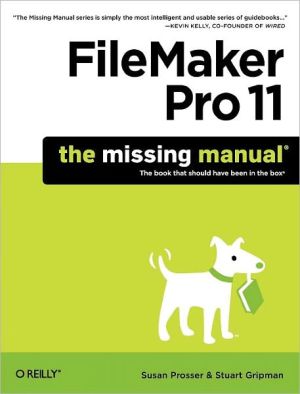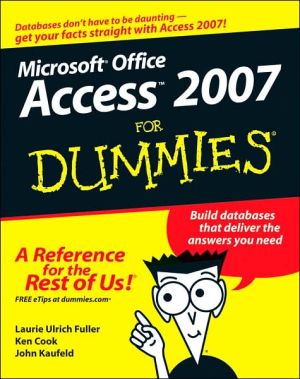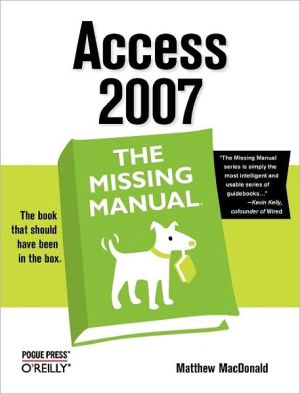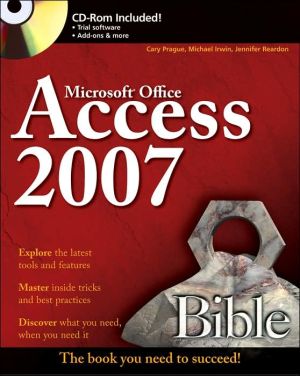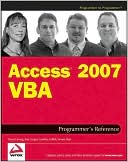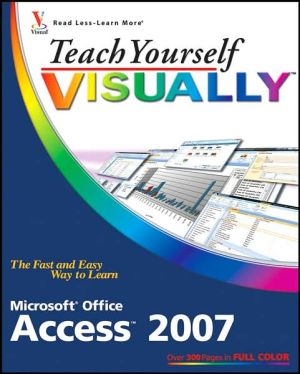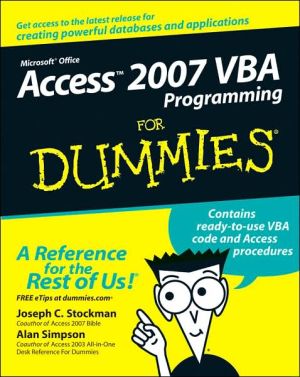FileMaker Pro 11: The Missing Manual
This hands-on, friendly guide shows you how to harness FileMaker's power to make your information work for you. With a few mouse clicks, the FileMaker Pro 11 database helps you create and print corporate reports, manage a mailing list, or run your entire business. FileMaker Pro 11: The Missing Manual helps you get started, build your database, and produce results, whether you're running a business, pursuing a hobby, or planning your retirement. It's a thorough, accessible guide for new,...
Search in google:
This hands-on, friendly guide shows you how to harness FileMaker's power to make your information work for you. With a few mouse clicks, the FileMaker Pro 11 database helps you create and print corporate reports, manage a mailing list, or run your entire business. FileMaker Pro 11: The Missing Manual helps you get started, build your database, and produce results, whether you're running a business, pursuing a hobby, or planning your retirement. It's a thorough, accessible guide for new, non-technical users, as well as those with more experience. Start up: Get your first database up and running in minutes Catalog your data: Organize contacts, to-do items, and product information with speedy data-entry and sorting tools Create professional documents: Publish reports, invoices, and more, with ease Add visual power and clarity: Create colorful charts to illustrate and summarize your data Harness processing power: Crunch numbers and search text with dozens of built-in formulas Learn advanced topics: Explore the high-level features of FileMaker Pro Advanced and FileMaker Server
The Missing Credits; About the Authors; About the Creative Team; Acknowledgments; The Missing Manual Series; Introduction; Why FileMaker Pro?; What's New in FileMaker Pro 11; The Very Basics; About This Book; Part one: Getting Started with FileMaker; Chapter 1: Working with a Database; 1.1 A Very Quick Database Tour; 1.2 Opening and Closing Database Files; 1.3 Adding Data to Your Database; 1.4 Navigating Your Database; 1.5 Finding Records; 1.6 Sorting Records; 1.7 Same Database, Different Views; 1.8 Saving Your Database; 1.9 Using FileMaker's Help Menu; Chapter 2: Organizing and Editing Records; 2.1 Views; 2.2 Advanced Find Techniques; 2.3 Editing What's in Your Fields; 2.4 Changing Text Appearance; 2.5 Checking Spelling; 2.6 Preview Mode and Printing; Part two: Building Your First Database; Chapter 3: Creating a Custom Database; 3.1 Creating a New Database; 3.2 Creating and Managing Fields in Table View; 3.3 Understanding Layouts; 3.4 Customizing a Layout; 3.5 Creating a New Layout; 3.6 Arrange and Align Tools; Chapter 4: Adding Power to Your Database; 4.1 Creating a Simple Calculation; 4.2 Creating a Related Table; 4.3 Creating and Using Portals; 4.4 Using Tab Controls; 4.5 Adding Merge Fields; 4.6 Writing a Basic Script; 4.7 Creating a Dynamic Report with the Assistant; 4.8 Creating a Trailing Group Report; 4.9 Changing the Default Account; 4.10 Summing Up; Part three: Thinking Like a Developer; Chapter 5: Creating and Managing a Relational Database; 5.1 Understanding Relational Databases; 5.2 Modeling Your Database; 5.3 Creating a Relational Database; 5.4 Using Relational Database Power; 5.5 Lookups; 5.6 Reviewing Relationship Concepts; Chapter 6: Field Options; 6.1 Understanding Field Types; 6.2 Auto-Enter Field Options; 6.3 Validation Options; 6.4 Storage Options; 6.5 Beyond Text: Container Fields; Chapter 7: Layout Tools; 7.1 Layout Parts; 7.2 Layout Types; 7.3 The Inspector's Data Tab; 7.4 Advanced Field Controls; 7.5 Data Formatting; 7.6 Buttons; 7.7 Tab Order; 7.8 Merge Fields; 7.9 Merge Variables; 7.10 Tooltips; 7.11 Autoresizing; 7.12 Creating Layouts for Printing; Chapter 8: Understanding Calculations; 8.1 Understanding Calculations; 8.2 The Structure of a Calculation; 8.3 Using a Related Field in a Calculation; 8.4 Understanding the Specify Calculation Dialog Box; 8.5 Auto-Enter Calculations; 8.6 Validate Data Entry with a Calculation; 8.7 Replacing Data Using a Calculation; 8.8 Comments; Chapter 9: More Calculations and Data Types; 9.1 Number Crunching Calculations; 9.2 Going Beyond Basic Calculations; 9.3 Text Calculations; 9.4 Date and Time Calculations; 9.5 Containers in Calculations; Chapter 10: Understanding Scripts; 10.1 Understanding Scripts; 10.2 Your First Script; 10.3 Shortcuts to the Edit Script Window; 10.4 The Importance of the Layout; 10.5 Running Scripts; 10.6 Organizing Your Scripts; 10.7 Branching and Looping in Scripts; 10.8 Script Triggers; Chapter 11: Exploring Script Steps; 11.1 Go to Layout; 11.2 Go to Object; 11.3 Scripting for Fields; 11.4 Working with Records; 11.5 Finding Records; 11.6 Sorting Records; 11.7 Working with Windows; 11.8 Working with Files; 11.9 Printing; 11.10 Other Script Steps; Part four: Becoming a Power Developer; Chapter 12: Applying Developer Utilities; 12.1 Copying and Pasting Database Structure; 12.2 Script Debugger; 12.3 The Data Viewer; 12.4 Disable Script Steps; 12.5 The Database Design Report; 12.6 Custom Functions; 12.7 Custom Menus; 12.8 Developer Utilities; 12.9 File Maintenance; Chapter 13: Advanced Relationship Techniques; 13.1 Advanced Relationships; 13.2 Portal Filtering; 13.3 Understanding Table Occurrences; 13.4 Table Occurrence Groups; 13.5 Understanding Graph Arrangements; 13.6 Connecting Database Files; 13.7 Using Multiple Relationship Techniques; Chapter 14: Reporting and Analysis; 14.1 Summary Fields and Sub-summary Parts; 14.2 Web Viewer Objects; 14.3 Conditional Formatting; 14.4 Basic Charting (Found Set Charts); 14.5 Chart Formatting; 14.6 Charting and Reports; 14.7 Advanced Charting; Chapter 15: Advanced Calculations; 15.1 Understanding Boolean Functions; 15.2 Using Storage Options; 15.3 Logical Functions; 15.4 The Let() Function and Variables; 15.5 Recursion; 15.6 Plug-Ins; Chapter 16: Advanced Scripting; 16.1 Commenting Scripts; 16.2 Importing Scripts; 16.3 Communicating with Database Users; 16.4 Organizing Complex Scripts; 16.5 Script Parameters; 16.6 Script Variables; 16.7 Handling Errors; 16.888888 Advanced Script Triggers; 16.9 Putting a Complex Script Together; Part five: Integration and Security; Chapter 17: Sharing Your Database; 17.1 FileMaker Network Sharing; 17.2 Sharing over the Internet; 17.3 FileMaker Server; 17.4 Server Hardware; Chapter 18: Adding Security; 18.1 How Security Works; 18.2 Privilege Sets; 18.3 Managing Accounts; 18.4 Extended Privileges; 18.5 Managing External File Access; 18.6 Scripts and Security; Chapter 19: Sharing Data with Other Systems; 19.1 Sharing Your Data with Others; 19.2 Snapshot Link; 19.3 External SQL Sources; 19.4 Exporting Data; 19.5 Importing Data; 19.6 Import Data Sources; 19.7 Importing and Exporting in a Script; Part six: Appendixes; Getting Help; Getting Help from FileMaker Pro; FileMaker's Installed Extras; The Quick Start Screen; Getting Help from the Community; FileMaker Error Codes;Susan Prosser is a reformed journalist who's stopped trying to bring information to the people and now helps them manage the data they already have. She is a FileMaker Certified Developer and has developed FileMaker databases for 12 years, and also trains and writes curricula for other developers.Stuart Gripman is the founder of Crooked Arm Corp, a full-service FileMaker Pro consulting and development firm based in Berkeley, California. A FileMaker Certified Developer, he has written for both Macworld and MacLife.
